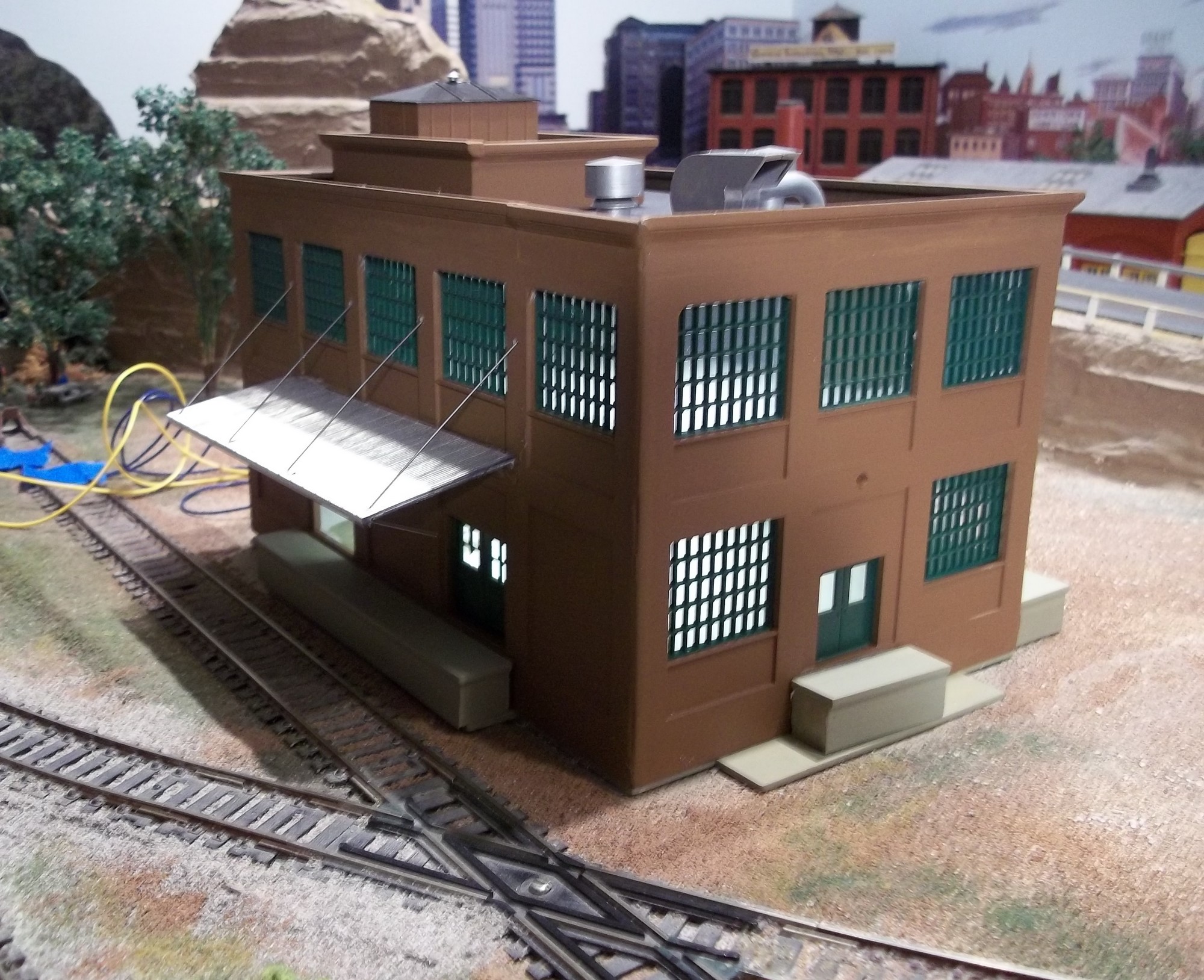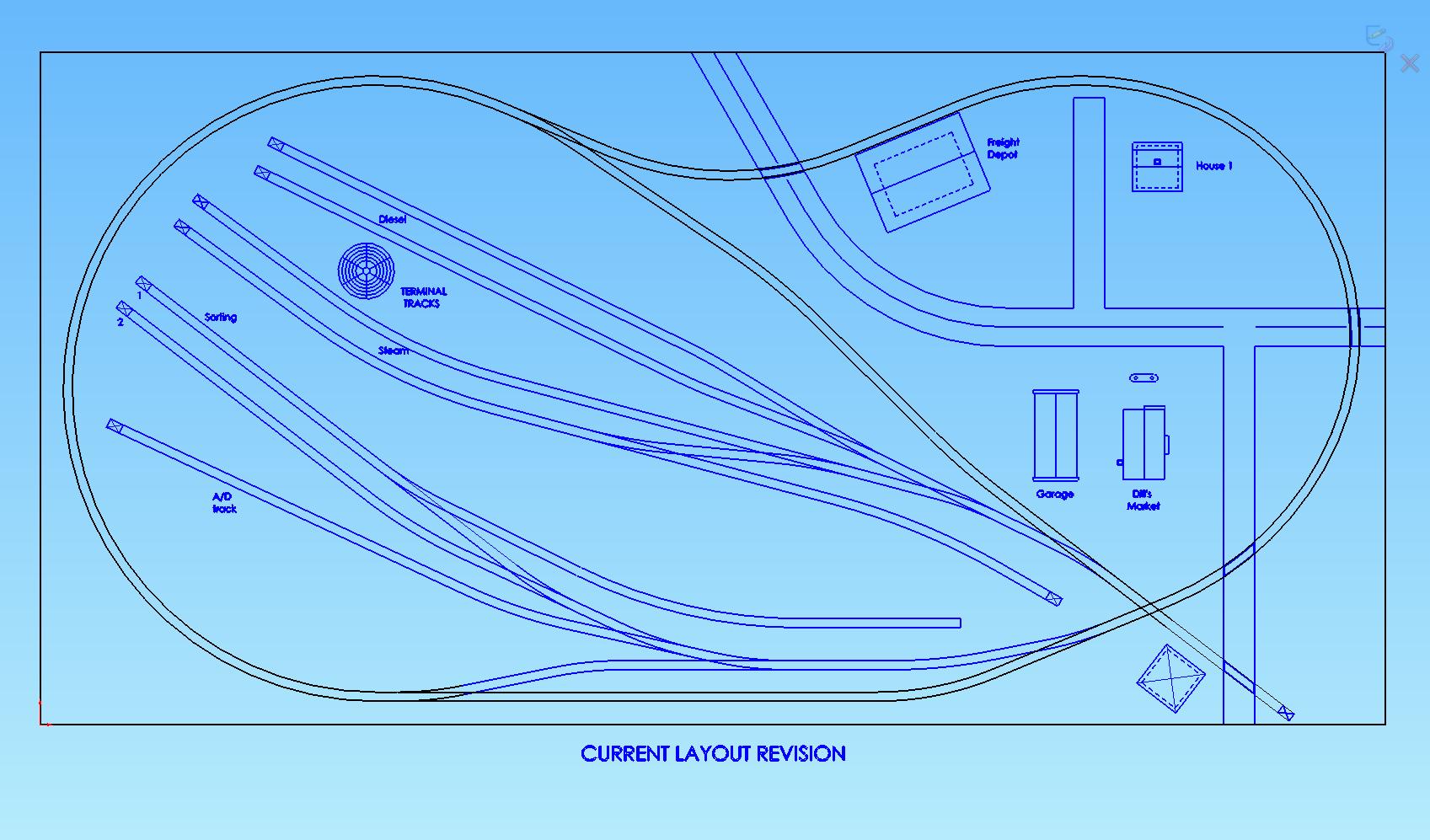Stealing a photo from Allan
 Not a double cross over or a set of turnouts.
Not a double cross over or a set of turnouts.
I feel like I need one, but I am not sure how to work one in.
Stealing a photo from Allan
 Not a double cross over or a set of turnouts.
Not a double cross over or a set of turnouts.
I feel like I need one, but I am not sure how to work one in.
Well, my layout was built with HO Kato track, and unfortunately they only offer a 90 degree crossing.
I too would have liked a 30 degree crossing. Even getting a 45 degree crossing would be helpful and useful, but in Kato track, it does not exist yet.
John
My Mel Double Crossover uses a 19° Atlas 572 crossing. It doesn’t require anything special, no special wiring or gaping.
Mel

My Model Railroad
http://melvineperry.blogspot.com/
Bakersfield, California
I’m beginning to realize that aging is not for wimps.
Isn’t it terrible to be in HO scale and use Kato Unitrack? I look at what they offer in N scale, and I get very jealous.
I would really like that stretchable straight track section that is available in N scale.
-Kevin
I had one, an Atlas 30 deg crossing, in the middle of a ‘scissor’ turning wye 6 years ago. That layout is no more…moved.
Obviously, this is during construction, but you can see the crossing in the lower foreground. I’m pleased to be able to claim that it worked well, but not smoothly with all items. Many staggered through it, no matter what I did in the way of flange path clearance, gauging, ensuring the plastic and rails matched at grade…I tried it all.
On my old layout I had an Atlas 60o crossing guarded by an interlocking tower:

The Atlas was SO noisy (from the interior plastic insulators molded too high) that I eventually swapped it out for a Shinohara, which was MUCH quieter. And, yea - no additional wiring needed.
Tom
Henry I haven’t had even a single problem with my 572, fast, slow, long cars, short cars or articulated locomotives since I installed it in 2012.
Mel

My Model Railroad
http://melvineperry.blogspot.com/
Bakersfield, California
I’m beginning to realize that aging is not for wimps.
i’m planning a 15 degree crossing between two overlapping stub sidings. And three 90 degree crossings (one industry spur crossing an industrial shortline, and the other two where the shortline crosses the double track mainline. All three are nearby, and protected by a tower. All N scale Unitrack.
I have one. I think it’s a 30 degree. When I got the crossing, an Atlas was available so I bought it. Eventually, I realized it had an internal short. The easy course was to replace it with a Walthers. The Atlas went in the trash can. Like others, I just wanted a crossing. I had to design a couple of short, stub-end sidings to accommodate it. Two more industries to switch. I mounted a big Kadee magnet uncoupler under it.
Mel your double crossover is great, but for my purposes, you are cheating, turnouts are involved.
I understand the concept of two different railroads crossing each others tracks, like Rochelle IL Deshler Oh
or Plant City FL
You have to have a big layout to use a 90 degree crossing unless one limb is just for show.
The Winston Salem has a crossing that can be used.
Maybe I am wondering if a crossing, not involving two separate railroads, is commonly used or commonly modeled?
I have a Walthers one and it is smooth as silk.

Henry, a crossing is a crossing, just because it is between turnouts doesn’t make any difference. All I did is chop a short piece of rail off the end, I didn’t do any modifications to the actual crossing.
Mel

My Model Railroad
http://melvineperry.blogspot.com/
Bakersfield, California
I’m beginning to realize that aging is not for wimps.
Mine is the turntable lead and inspection pit which crossed two main line tracks and a lead to the coal wharf:
 Turntable_lead-b by Edmund, on Flickr
Turntable_lead-b by Edmund, on Flickr
I’d like to make a single-arm crossing signal here. It is on the drawing board.
 Turntable_lead by Edmund, on Flickr
Turntable_lead by Edmund, on Flickr
Walthers Shinohara code 83.
Good Luck, Ed
A friend gave me a crossing - not sure of the brand - maybe Peco or Walthers/Shinohara, but since it was in good condition, there was no need to fix it. [:P]

If I had had more room, though, a couple of turnouts would have been more versatile. It serves as an interchange point with a friend’s layout (a couple of tracks in my workshop, through a hole in the wall).
Wayne
Crossings have always been a critical part of my trackwork. I primarily use them on my double mainlines to cross from the outer mainline over the inner mainline to reach yards or sidings, but I also use them inside my passenger station complex.
This first photo shows a crossing from the outer mainline over the inner mainline to reach one of the passenger station lead tracks.

This second photo shows back to back crossings from one of the four passenger station lead tracks over two of the mainline lead tracks to reach the fourth passenger lead track. Those two outer lead tracks feed LCL cars into the various sidings for the large freight houses that dominate the landscape inside the Dearborn Station complex.

All of my crossings are Peco Code 83 #6 Crossings.
Rich
We have one. Crosses the mainline to access our engine yard.
Two aspects to watch for. the back to back frogs create a potential for short wheelbase locomotives crawling across the frogs to stall. Using powered frogs as for turnouts would solve that difficulty but polarity control is needed for that.
Secondly, if power can reach frogs from two different sources which might be opposed polarity you can get shorting from wheels as they cross the frogs. This is a DC problem if the two crossing tracks are in separate blocks and can be powered from different powerpacks. I suppose a DCC booster conflict could arise in analogous circumstances.
The only reason to create special wiring would be to automate collision control. You could wire the two crossing tracks so that only one track is powered at one time. We plan on using either a snap relay or a Peco microswitch to control power to the crossing depending on the throw of turnouts on the engine yard access line. The idea being that one track of the crossing is always dead for a few inches on each side, the two crossing tracks being in separate blocks.
I modeled an interchange with one on my last layout, and yes it was a “dummy” extension from a small interchange yard.
Sorry no photos.
That layout and the new layout design have lots of double track diverging routes that use crossings. One day I will post of photo of that trackwork magic, I use Atlas 12.5 degree crossings with #6 turnouts, on 2" track centers by modifing the turnout and the crossing adding a slight curve between the turnout frog and the crossing diamond. Saves a lot of space compared to using a #6 (9.5 degree) crossing.
I do have a spot on the new layout where I am considering a totally dummy other road track with a pair of crossings.
Sheldon
I have a triple crossing using Atlas (yes, bumpity-bump-bump) 90-degree code 83 crossings. It is a tight layout so this is the entry to the engine service area.
 20200424_084045 by Paul Ahrens, on Flickr
20200424_084045 by Paul Ahrens, on Flickr
 IMG_7190 by Paul Ahrens, on Flickr
IMG_7190 by Paul Ahrens, on Flickr
Nothing wrong with that, Paul. Love the sound on locomotive wheels pounding on those diamonds.
Rich
This is my HO/HOn3 ~12.5 degree crossing. First piece of handlaid track I ever built.

It is gapped with directional power controlled by this switch.

The crossing serves to allow standard gauge access to the south end of Durango yard (my Durango is dual-gauge) and gives access to the station’s dual-gauge passenger track from the narrowgauge main to Chama.

I call it Carbon Junction and this tower overlooks things.
